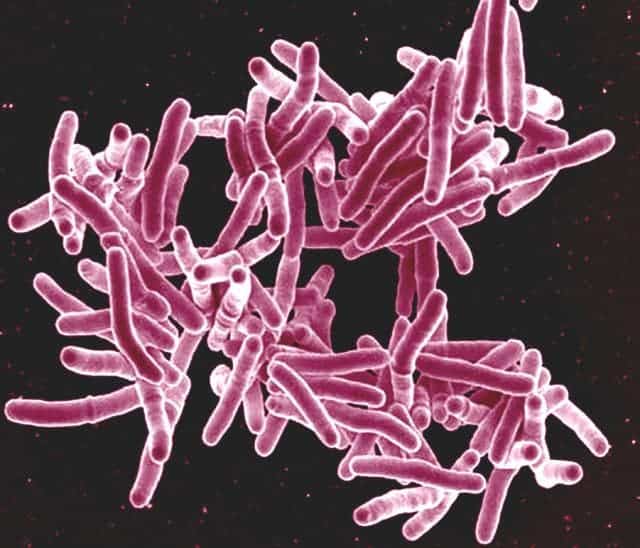
Scanning electron micrograph of Mycobacterium tuberculosis bacteria, which cause TB. Credit: NIAID, Flickr.
World TB Day is celebrated every year on March 24 to raise public awareness about the devastating health, social and economic consequences of tuberculosis (TB). World TB Day 2018 is exceptionally noteworthy because never in the history of TB has there been more attention and commitment to ending the infectious disease that kills 1.7 million people each year.
The animation below shows how TB spreads in the body and how the immune system fights it. It also illustrates the different ways the TB bacterium can develop into the disease; either through overwhelming the immune system (common in children) or by latent TB waking up and becoming active (typical for those with weak immune systems such as older people, those who are HIV positive, or have had organ transplants or chemotherapy).
Global progress depends on advances in TB diagnosis, prevention, and care in countries with high TB burden. In celebration of World TB day, here are eight new developments about tuberculosis drugs, vaccines, and diagnostics.
- TB is diagnosed using a skin test, or by culturing bacteria from a person’s sputum. Both methods can only be performed by trained microbiologists and may take several days to give results. Good news! Professor Alessandra Luchini, of George Mason University in Virginia, and her team developed a urine test that detects a specific sugar that coats the surface of TB bacteria and gives results in half a day.
- A team of chemists working in collaboration with doctors and public health researchers in South Africa has developed a new test that makes it easier to diagnose TB. The test developed by Professor Carolyn Bertozzi and the team at Stanford ChEM-H is called DMN-Tre and takes just a few steps and produces results in under an hour. They attached the sugar trehalose to a fluorescent dye that, once ingested, glows about 700 times brighter than before. When you see a very bright cell, it means live tuberculosis is present.
- The only licensed TB vaccine, BCG (Bacillus Calmette Guerin), was developed by Albert Calmette, a French physician and bacteriologist, and Camille Guérin, a veterinarian more than a century ago. However, a new study suggests that when given to adolescents who had been vaccinated as infants, a single dose of BCG could prevent a sustained TB infection by 45 percent.
- A newer live attenuated TB-vaccine ‘MTBVAC’ developed by Biofabri, Professor Carlos Martin and his team at the University of Zaragoza has finished Phase 1b trials carried out in healthy HIV unexposed newborn infants in South Africa, a country highly endemic for tuberculosis. MTBVAC was found to be well tolerated and induced a dose-dependent immune response that was distinct from the response induced by BCG. A subsequent Phase 2 trial in newborns to confirm its safety and to determine the final dose will go ahead in the next months.
- To create a better TB vaccine, a better understanding of the pathogenesis of TB is essential. A granuloma is an aggregate of cells and is the pathological hallmark of TB. To study how granulomas form, Professor Joanne Flynn and colleagues from the University of Pittsburgh use animal models, mainly using different macaques to watch how infection spreads in real-time. Flynn and her team developed an imaging modality called PET/CT, which uses fluorodeoxyglucose (FDG) as a probe, just like in cancer studies where they measure the level of inflammation or metabolic activity for each granuloma.
- The World Health Organization (WHO) has requested drug makers to submit an Expression of Interest (EoI) for Bedaquiline and Delaminid, two new-generation drugs, recommended for drug resistant-TB. Drugs passing the standards (or pre-qualified) will then be included in a list for procurement by the UN and other organisations. This will ensure more manufacturers to supply quality medicines, which will make the market more competitive and prices more affordable.
- XDR-TB refers to strains of TB that are resistant to rifampicin and isoniazid and a fluoroquinolone and at least one of the three injectable TB drugs, capreomycin, kanamycin, and amikacin. The Nix-TB trial is the first TB clinical trial to test a new drug combination which has the possibility of being a shorter, all oral, and affordable treatment for XDR-TB. This combination does not require injections and has far fewer pills.
- Research conducted by Rockefeller scientists offers hope for a new and potent weapon against tuberculosis. Their work focuses on an antibiotic that kills MTB in the laboratory but is not suitable for clinical use. Fidaxomicin is uncommonly adept at killing tuberculosis cultivated in the lab. However, when taken orally, an antibiotic must be absorbed by the gut and eventually reach the lungs – but fidaxomicin is unable to do so. By understanding how fidaxomicin operates, the research by Rockefeller scientists could allow others to design new antibiotics that could be used to treat tuberculosis patients and might even work on other bugs.










